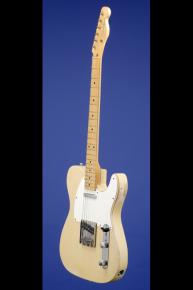Floats Like a Butterfly --
Stings like a Bee…
This fifty-three year-old Telecaster went back to the Fender factory in early 1959 to be re-necked (this was of course Leo Fender's original concept back in 1949). This great guitar weighs just 7.50 lbs. and has a nice fat nut width of just under 1 11/16 inches, a very comfortable medium-to-thin neck profile, and a scale length of 25 1/2 inches. Solid ash body, one-piece maple neck with 21 frets and black dot position markers. Headstock with Fender "spaghetti" logo in silver with black trim and "Telecaster" in black beneath. Original circular string tree. Individual single-line "no-name" Kluson Deluxe tuners with oval metal buttons (stamped on the underside "2356766 PAT APPLD." The neck has no pencil date (which is usual for early '59). Four-bolt neck plate with serial number ("12010") between the top two screws. One plain metal-cover "black-bottom" pickup with slot-head adjusting screws (at neck) with an output of 6.28k, and one black six-polepiece "copper-coated metal plate bottom" pickup with staggered polepieces (angled in bridgeplate) with an output of 5.96k. The bridge pickup cavity is dated in blue pencil "9-56". At the time of the neck replacement the Fender factory re-used the original 1956 "no-name" Kluson tuners and circular string-tree. They also changed the pickguard for the eight-screw single-layer white ABS (.080 inches thick) version - most probably because of the inherent 'buckling' problem with the original thinner .060 inches thick five-screw guard (the original five screws align perfectly within the eight screw-hole guard). Two controls (one volume, one tone) plus three-way pickup selector switch and original Daka-Ware black plastic "Top-Hat" tip, all on metal plate adjoining pickguard. Shorter chrome knobs with flat domes and knurled sides. Telecaster combined bridge/tailpiece with three, quarter inch steel, smooth saddles. the potentiometers are stamped "304 620" (Stackpole April 1956), and the three-way switch is stamped "CRL 1452."
This guitar is in excellent plus (8.75) condition. There is some belt buckle scarring on the back, and a fair amount of playing wear, mainly on the edges. The original frets show very little playing wear and there is virtually no playing wear on the maple board. The Blond has mellowed to a rich, creamy color. The lovely grain of the ash body shows very well through the finish, and this fifty four-year-old gem is quite simply one of the best sounding "white guard" Telecasters that we have handled! Housed in the original Fender tweed hardshell case with light red plush lining (8.75).
This guitar gives you the very best of both worlds -- the sound of a '56 Tele with that early '59 medium profile neck that so many players prefer.
"Leo Fender's new solidbody was the instrument that we know now as the Fender Telecaster, effectively the world's first commercially successful solidbody electric guitar...The guitar was originally named the Fender Esquire and then the Fender Broadcaster, and it first went into production in 1950. It was a simple, effective instrument. It had a basic, single-cutaway, solid slab of ash for a body, with a screwed-on maple neck. Everything was geared to easy production. It had a slanted pickup mounted into a steel bridge-plate carrying three adjustable bridge-saddles, and the body was finished in a yellowish color known as blond. It was unadorned and like nothing else. It was ahead of its time (Tony Bacon, 50 Years of Fender, p. 10).
"Both the Telecaster and the Esquire kept their basic 1951 appointments until the mid-50s. In retrospect, their most striking features -- at least cosmetically speaking -- are a typical yellowed blonde finish (a.k.a. 'butterscotch' finish) and a black pickguard, hence the often cited notion of early 'black guard' Tellies. The combination of the two actually gives a distinct look to the early 50s models, which are otherwise considered by many as the ultimate classic Telecaster guitar because of their tone...Besides its peculiar hue, the original blonde finish nicely showcases the ash body heavy grain pattern that later whiter finishes would subdue...[1954] marks the beginning of a number of changes in the appointments of Telecaster guitars. By Fall, the bakelite black guard was replaced by a single ply white trim and a few months later steel superseded brass for the bridge saddles. FENDER also changed the finishing process of the blonde finish...The typical 'butterscotch' colour gave way to a creamier shade which would soon evolve into a lighter off-white finish. Finally, 1954 is also the year when the serial number was removed from the bridge plate to be stamped on the neck anchor plate...Beyond these cosmetic features, a more dramatic evolution took place in 1955. The bridge pickup was modified to incorporate staggered pole pieces in place of the flush level-poles of the original design...Finally, the round clubby neck of the post-1950 guitars evolved into pronounced 'V' feel by 1955 and until early 1958 'boat necks' were the rule on most Fender instruments...At the end of 1956, Telecaster guitars no longer looked or even sounded exactly the same as the 1951 models...In the course of 1958, necks gradually changed for a flatter cross section" (A.R. Duchossoir, The Fender Telecaster, p. 16).
Translate:









